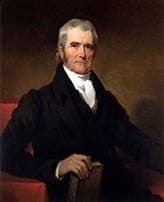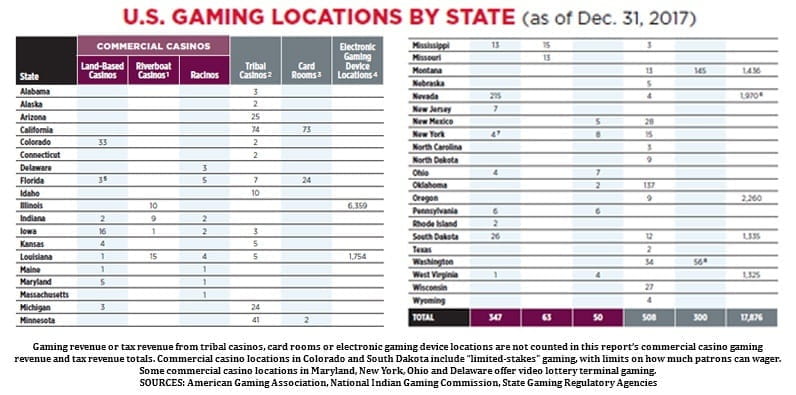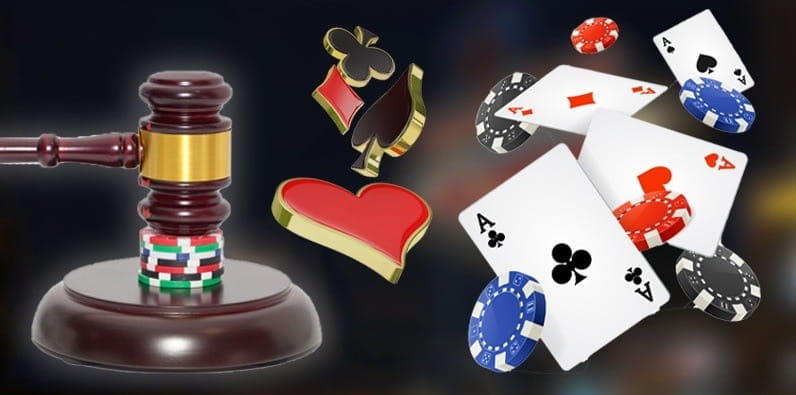Here we aim at the retrospective description of the factors that fueled the emergence and legalisation of Indian gaming venues. We also discuss the current situation with facts and figures and explain some of the major myths regarding casino operations on tribal land.
History of Native American Gaming Establishments
Gaming operations of Native Americans date back to the 1980s when a series of Supreme Court rulings speeded up the passing of the Indian Gaming Regulation Act. The bill was enacted in 1988 and set the current legal framework under which Indian casinos operate. The roots of gaming for profit, however, can be found in the concept of the sovereignty of indigenous American people. That said, why Native American casinos exist is not a question of gambling regulation, but a question of self-sufficiency and self-governance of the tribes.
Native American Sovereignty
 John Marshall (1755 – 1835)4th Chief Justice of the US
John Marshall (1755 – 1835)4th Chief Justice of the USTraditionally there’s been a great deal of controversy about the status of indigenous American people. Laws and policies aimed at defining the relationship between the Federal Government and Native Americans have existed since the 1830s. These policies have been steered in different directions throughout the 19th and the 20th centuries, resulting in the enactment of several bills.
An 1831 declaration by the Chief Justice John Marshall of the Supreme Court says that that Native Americans were “domestic dependent nations”. Their relationship with the US government was supposed to be like “of a ward to his guardian”. Efforts were committed to addressing the issue of the dual status of Indians. At the time they were both separate nations and part of the United States, and the resulting ambiguity hindered the legislative effort to resolve pending issues.
New bills continued to appear in the 20th century with the Indian Reorganization Act from 1934 being the most notable example. Nowadays the Federal Government continues to recognise Native American tribes as sovereign nations.
A part of this recognition is the acceptance that tribal leadership has inherent authority and ability of self-governance. This sovereignty is the root cause for the emergence and proliferation of gaming operations on tribal land.
The Foundations of the Modern Indian Gaming Regulation
Going back to gambling, the story of Indian casino venues began in 1981 with a court ruling on the famous Seminole Tribe of Florida v. Butterworth case. In 1979 the Seminole Tribe opened on their reservation the first Indian high-stake bingo. Multiple arrests immediately followed that. According to local authorities, the tribe event violated the then-current statute of bingos and the allowed opening times, number of jackpots and prize value.
State law enforcement responded accordingly, and the tribe was forced to file the mentioned lawsuit. After weighing the reasoning of both sides, the District Court ruled in favour of the Seminole people. Naturally, the state brought the case to the Court of Appeal, where in 1981 the initial ruling was confirmed, and an extended argumentation was given. This ruling was quoted later in 1987 in another notable gambling related case – California v. Cabazon Band of Mission Indians. In this case, the decision was again in favour of the Indian tribe.
Tribal Autonomy versus Federal Laws
Before the 1950s Native American territories and Indian related matters were subject to independent federal oversight, mainly by the Bureau of Indian Affairs within the U.S. Department of the Interior. However, in 1953 a federal law was enacted which brought a big change, albeit only in selected states. It is called Public Law 280 and allows state law enforcement to assume jurisdiction over cases when crimes are committed on tribal land and involve native people.
Florida was not among the six states where the bill took effect initially. The state accepted Public Law 280 eight years later, in 1961. The transfer of authority from federal to state law enforcement according to this bill was among the main arguments brought by the state of Florida in the Seminole Tribe of Florida v. Butterworth case.
A Question of Semantics
Two main arguments motivated the key court rulings in favour of the two Indian tribes. First, the federal policies aimed at promoting the economic self-sufficiency of the tribes were considered of higher importance. Secondly, Public Law 280 allowed the states to enforce only criminal laws on tribal land. Therefore, in each case, the court had to establish if the applicable gaming bill in the respective state was civil or criminal. Both Florida in 1981 and California in 1987 argued that this should be based on whether violations resulted in criminal penalties. The court, however, demanded that the definition should derive from a prohibitory function of the law. Since the existing laws regulated certain forms of gambling but did not prohibit them, it was concluded that these were not criminal matters and state authorities had no jurisdiction.
The Indian Gaming Regulation Act of 1988
Even though the series of court rulings in favour of Native American gaming establishments, the future of such operations was quite unclear. There was no way of revealing how long the Federal Government would support gambling as a means of promoting tribal self-sufficiency and economic independence. The need for a federal law was obvious.
In 1988 a bill was enacted that was supposed to resolve the pending issues. It is called the Indian Gaming Regulatory Act (IGRA), and it still regulates the Native American gaming businesses today. It’s a common belief that the bill was written in response to the two big victories the Seminole and Cabazon won in court. The fact is, however, that the law had already been drafted by the time of the Cabazon case. The necessity of such a bill was apparent regardless of the ongoing lawsuit, but the verdict helped to speed up the enactment.
Current Regulation of Native American Casinos
During the debates about IGRA, two main lobbies supported the opposing interests of the states and the tribes. States insisted that all gaming on Indian land should be subject to the same regulation as non-Indian operations. That includes the same statutes, rules and taxation. Native Americans, on the other hand, fought for exclusive control by the tribes. The final solution is balanced somewhere in the middle and revolves around the classification of gaming operations. Check the paragraphs below, where we outline the main points in the Indian Gaming Regulatory Act.
Gaming Classes
IGRA defines three classes of gaming operations and sets separate regulatory measures for each of them. As you can guess, the most scalable and lucrative types of games are the most regulated ones.
- Class I Gaming – this category includes
social games solely for prizes of minimal value or traditional forms of Indian gaming engaged in by individuals as a part of, or in connection with, tribal ceremonies or celebrations
. - Class II Gaming – this type includes bingo, lotto and other similar games. Some card games are also included here, as long as they are either authorised in the respective state or not explicitly prohibited. However, banking card games, such as blackjack are excluded.
- Class III Gaming – the definition in the law is
all forms of gaming that are not class I gaming or class II gaming
. The definition of class II suggests that all banking card games fall under class III, together with slot machines. Essentially all games typical for commercial casinos are in this category.
The responsibility for the regulation of the different gaming activities is distributed between the tribes, the Federal Government and the States. Class I gaming is ultimately regulated by the tribes. Class II requires the adoption of a gaming ordinance issued by the National Indian Gaming Commission (NIGC). Also, class II games must not be prohibited by the state where the venue is established. State rules on hours of operation, wager limits or pot size limits also apply. Finally, class III games must be legal in the state where the operation is set, must be authorised by an NIGC ordinance, and …conducted in conformance with a Tribal-State compact
.
Tribe-State Compacts
Tribal-State compacts are the area where balance is sought between the interest of the tribe and the interest of the respective state when it comes to Native American casinos. As mentioned, class III games are the most regulated, and this is where states are given a chance to participate in defining the scope of the operation. IGRA requires that the parameters of class III venues on tribal land are negotiated in good faith between the tribe and the state authorities. That means that states can’t just say no to a proposal for building a casino, and in case of reluctance tribes can sue the state. When an agreement is reached, it is formally sealed with a contract called a Tribe-State compact. Perhaps the most important clauses in the compacts are those on the monetary contribution of the casino to the state budget. Since industrial style casinos can be a substantial revenue source, states naturally want to have a way of tapping in.
The Role of the National Indian Gaming Commission
The Indian Gaming Regulatory Act establishes the official regulatory body for Native American gaming operations. The National Indian Gaming Commission works within the Department of the Interior and consists of three members – one Chairman and two Associate Members. The Chairman is …appointed by the President with the advice and consent of the Senate
. The Secretary of the Interior appoints the Associate Members. The NIGC has several main responsibilities:
- It monitors class II gaming on tribal lands and can inspect venues where such games are conducted. It has the right to demand access to, and examine company books and records.
- The Chairman can approve fines for venues in violation. He can also order temporary closure of gaming operations.
- The Commission approves gaming ordinances which are required for class II and class III establishments.
- NIGC also approves management contracts for class II and class III venues. Such contracts are quite common, as tribes tend to outsource casino management to companies with experience in the industry.
The NIGC is essentially the instrument of the Federal government for regulation of Native American casinos and the enforcement of the provisions of IGRA. It’s interesting to note that according to the bill at least two of the Committee members must be Native Americans, and no more than two of them should be from one political party.
Spending of Gaming Revenue
IGRA has provisions of critical importance to the distribution of gaming revenue. One of the myths related to Indian casinos is that tribes can spend their income however they want to. In fact, there are limitations related to revenue allocation by the tribal government. Here’s what Native Americans can spend their gaming revenue on.
- Funding of the tribal government operations;
- Improvement of the general welfare of the community and its members;
- Facilitate economic development within the community;
- Make charitable donations;
As you can see, IGRA determines that gaming revenue can be spent on programs and projects that are aimed at improving the tribe’s economy and wellbeing. That said the revenue allocation provisions, and the act, in general, is an extension of the federal policy for promoting tribal self-sufficiency.
Current State
Given that casinos are a means of promoting the economic independence of Native Americans, it would be good to have an estimation of the economic impact of these operations. Of course, the easiest way is to compare them to commercial casinos. Тhere are quite a lot of nuances behind the numbers. For instance, a substantial part of gaming revenue goes as payments to management companies, or to the states according to the existing compacts. Nevertheless, regardless of the allocation, this is still revenue, and it has an economic impact. Let’s take a glance at the numbers in the following paragraphs.
The Numbers
As mentioned, class II and class III operations can be established only in states where they aren’t explicitly prohibited. That said, not all states have Native American casinos. According to the NIGC register, there are 28 states with class II and class III operations on tribal land. The largest concentration of Indian gaming venues is in Oklahoma, where 27% of all class II and class III operations are located. Out of 508 venues across the US, 137 are in this state. For comparison, California holds second place with 77 establishments. The 2018 State of the States survey by the American Gaming Association says that non-tribal commercial casinos are 410 altogether, of which 347 are land-based and 63 are riverboat casinos. To no surprise, a little more than half of them (215) are in Nevada.

It’s worth mentioning that only tribes that are officially acknowledged by the federal government can open gaming venues. That said, 243 tribes run a class II or III site. However, class III games, which generate big money, are conducted only by 12 tribes in 27 locations. The Cherokee holds the record here in Oklahoma with 11 operations or 40% of all class III venues. Other tribes run a more significant number of gaming establishments, but they conduct only class II games. As seen above, despite the more substantial overall number of operations, Native Americans run a tiny percentage of casinos with class III games. Therefore, the revenue comparison speaks about a great disbalance between tribal and non-Indian gaming venues.

Full yearly revenue summary for 2018 is still not published by official sources, at least not to our knowledge. The NIGC stats say that the 2017 revenue of Native American gaming operations was $32,4 billion. In comparison, commercial gaming, which is the other significant segment, generated $39.9 billion. Percentage-wise, in the same year tribal and commercial gaming, had a 42.6% and 52.2% share respectively.
Common Myths and Misconceptions
There are several popular beliefs about tribal gaming operations that turn out to be untrue. Most of them come from the seemingly impressive aggregate stats and the general notion that the Federal Government supports gaming as a way for tribes to seek economic self-sufficiency.
Easy Money
One of the most popular myths about Native American casinos is that they are an easy source of income for the tribes. Despite a large number of operations and the impressive aggregate amount of money they generate, there are indications of great imbalances. Some Indian gaming venues are more attractive than others because of their much better location. Quite a lot of the Indian gaming establishments are in remote and poorly developed areas. Also, most venues across the country offer only class II games. That said, not all tribes have an equal start, and their capacity to make scalable amounts of money is not the same. The notion of Las Vegas-style casinos spreading all over tribal lands is far from true.
Native American Casinos Can be Opened Anywhere and by Anyone
We said a quick word about tribe acknowledgement by the Federal Government. Not all communities of native Americans are officially recognised as tribes. Therefore, not all land owned by Native Americans counts as tribal land. Casinos can be opened on the area adjacent to the Indian reservations, but there are limitations to that. Furthermore, opening a casino requires a Tribe-State compact for allowing class III games to be conducted, provided such games are not prohibited in the state. As seen above, class III venues are a rarity.
Casino Revenue Is Distributed Directly Among the Tribe Members
The so-called per capita payments are allowed but are quite rare. Also, such payments are subject to taxation. Tribal governments are obliged to inform the community that this is a taxable income and beneficiaries must declare this income. Also, tribal leaderships rarely recognise per capita payments as a wise way of allocating gaming revenue. Many believe this discourages young people from pursuing education and career achievements. Reliance on direct payments as a single source of income for the households is not seen as a benefit for the communities.
Tribes Are the Sole Beneficiaries of Gaming Operations
There are quite a lot of hands in the pot. States take a portion according to the negotiated Tribe-State compacts. Also, many tribes enter management contracts with third parties who run the operation and take a fee for their service. Investments are financed with huge loans that need to be paid. That said, for Native Americans casinos, the cost of doing business isn’t low at all.



